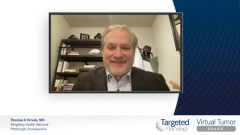
Case 1: Guideline Recommendations for PARP Inhibitor Use in Ovarian Cancer
Thomas C. Krivak, MD, leads a discussion on guideline recommendations regarding the use of PARP inhibitors in newly diagnosed advanced ovarian cancer.
Episodes in this series

Thomas C. Krivak, MD: With respect to the ASCO [American Society of Clinical Oncology] diagnosis, we talked about early stage I/stage II, no PARP therapy is recommended because the studies haven’t done that. For full disclosure, if I had a patient with stage II ovarian cancer and a BRCA mutation, I’m probably going to think long and hard if I’m going to consider using some type of maintenance therapy for a little bit of time, because those patients still, at times, will still have about a 30% chance of recurrence. Stage III/stage IV, we had all talked through this already. All women with high-grade epithelial ovarian cancer, high-grade serous, or high-grade endometrioid cancer, don’t need to worry about HRD [homologous recombination deficiency] patient status or BRCA. If somebody is struggling with understanding testing, they can go ahead and just place these patients on niraparib [Zejula]. Looking at germline or somatic mutations, olaparib [Lynparza] can be utilized, and, again, patients who are HRD positive, that were started on bevacizumab, [Avastin], you can consider utilization of olaparib/bevacizumab as well.
We talked through all these adverse effects and how we may juggle these medications around, as well as some of the dosing and how we would apply these medications or combination of medications to this patient as well as other patients similar to her.
Cecelia H. Boardman, MD: I would say, Tom, go back to that slide. There’s a subtlety, right? No, the guidelines. The subtlety is ASCO says early stage and they put stage II in with early stage and they say PARP inhibitor not recommended. But when you look at NCCN [National Comprehensive Cancer Network] guidelines, and traditionally, like in the European patient population, stage II is rolled into stage III and gives you the opportunity to use PARP maintenance if you’re following NCCN guidelines. It’s in there that stage II incorporated with III and IV, even though all of those clinical trials looked at stage III/stage IV patients only. I’ve always said that stage II disease doesn’t exist. It’s the failure of the surgeon to find the stage III disease. You’ve got to look at the subtlety of how detailed the staging operation was, did they have peritoneal biopsies, did they have fully lymphadenectomy, because we know that with lymphadenectomy, we’re going to upstage at least 35%. The subtlety is looking at how adequate was their staging and how concerned are you about that patient. But NCCN allows you to offer PARP for this select stage II patients if you think it’s appropriate.
Thomas C. Krivak, MD: Very good point. The NCCN guidelines for BRCA1/BRCA2 breaks down into bevacizumab versus no bevacizumab, and we talked about this as we were developing the treatment plan for our patient. Again, if you don’t start people on bevacizumab, BRCA wild type, niraparib or observation; BRCA mutated, niraparib, olaparib, or observation again. If you had a BRCA mutated and you’re not giving a PARP, the observation bothers me. I guess there are going to be people that decline it. But, to me, you have your first-string quarterback, your second-string quarterback, you’re always going to go with your first-string quarterback if they’re available. You’re just not going to start your second-string quarterback. To me, these need to be ranked down, and observed.
Then looking at bevacizumab upfront, BRCA wild type, HRP [homologous recombination proficiency] unknown, you can use single agent bev [bevacizumab] if they’re HRD positive, bev [bevacizumab] with olaparib; BRCA1 and BRCA2 mutated, bevacizumab plus olaparib, niraparib, or olaparib alone. You can take them off the bevacizumab is what they’re saying. As you were saying, Cecelia, there’s a lot of nuances within these different recommendations coming from different study groups. This is a nice summary and we all talked about it. But I do get a little bit nervous that observation is in there with respect to BRCA1/BRCA2. Not all patients are going to want maintenance therapy, they’ll elect for observation, I’m not sure if that should be a recommendation from us.
Transcript Edited for Clarity











































